The Top 10 Dangerous Cities in the U.S. reveal a challenging landscape for urban safety, with each city on this list facing unique but significant safety and crime issues.
This article provides an in-depth look at these cities, ranking them according to crime rates and examining the primary issues and high-risk areas contributing to their status among the Top 10 Dangerous Cities in the U.S.
10. Indianapolis, Indiana

- Violent Crime Rate: Roughly 1,334 per 100,000 residents, with violent crime rates rising in certain neighborhoods.
- Crime Concerns:
- Homicide, aggravated assaults, and robberies are frequent in areas with high poverty.
- Limited opportunities for youth and lack of community engagement.
- Drug-related crimes are common, fueling other violent offenses.
- High-Crime Areas: Near Eastside and Martindale-Brightwood.
- City Initiatives: Police-community relations programs, youth education, and local partnerships focusing on economic revitalization.
Indianapolis, the largest city in Indiana, is known for its rich history and culture, but it’s also plagued by a rising crime rate that ranks it among the top 10 dangerous cities in the U.S. Violent crimes have increased significantly over recent years, with a current rate of about 1,334 incidents per 100,000 residents.
Much of this crime is concentrated in areas such as Near Eastside and Martindale-Brightwood, where poverty rates and limited economic opportunities remain persistent problems.
Efforts are underway to combat crime through community policing and social programs aimed at reducing gang involvement and creating safer environments.
Law enforcement officials in Indianapolis are taking steps to curb violence, but significant work remains to be done to address the root causes, including poverty and limited access to resources.
9. Milwaukee, Wisconsin
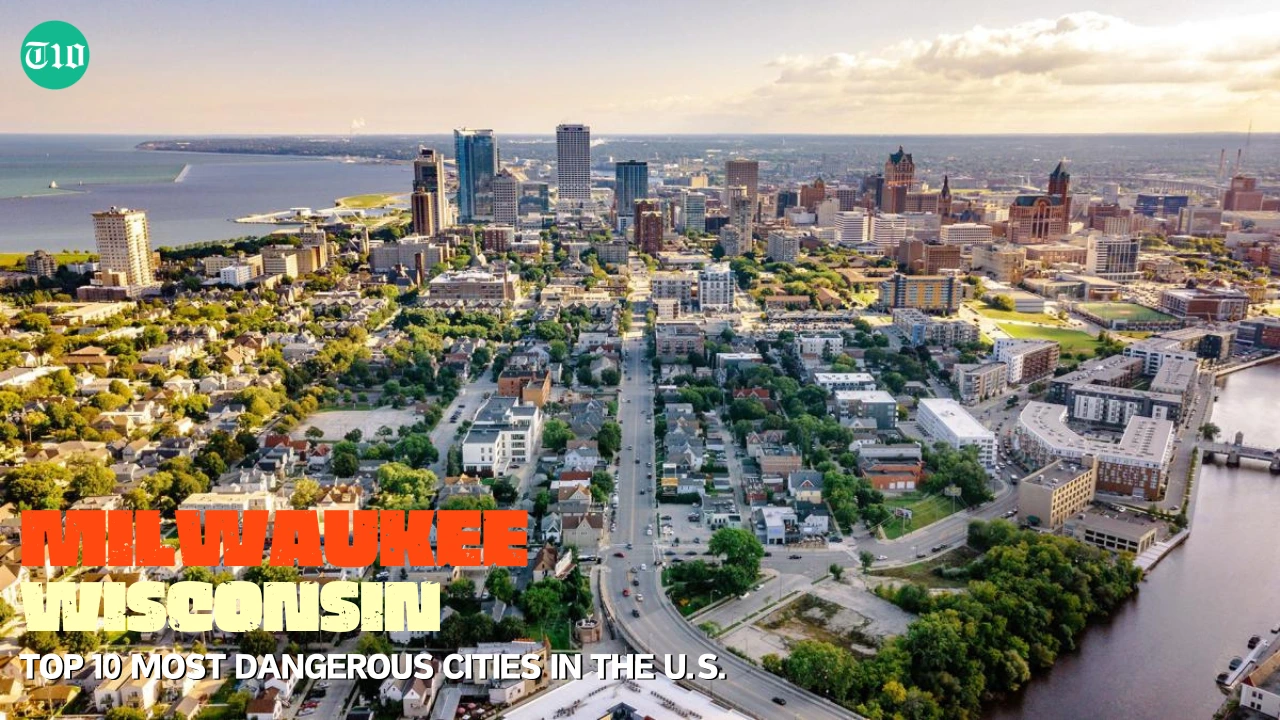
- Violent Crime Rate: Around 1,332 per 100,000 residents, with gang-related activity as a main driver.
- Main Issues:
- Gang violence and drug trafficking contribute to high crime rates.
- Economic hardship and limited access to resources in neighborhoods.
- Property crime rates are also higher than the national average.
- High-Risk Neighborhoods: Metcalfe Park and Harambee.
- Crime Prevention Efforts: Initiatives targeting gang prevention, job training for at-risk youth, and increased police involvement.
Milwaukee, the largest city in Wisconsin, has consistently appeared on lists of the top 10 dangerous cities in the U.S. due to its high crime rates.
Violent crimes such as homicides and robberies are particularly prevalent in neighborhoods like Metcalfe Park and Harambee, with a rate of approximately 1,332 incidents per 100,000 people.
Drug activity and gang violence remain major issues, contributing to an environment of insecurity for both residents and visitors.
To improve safety, Milwaukee has invested in initiatives to tackle gang violence and provide educational programs for at-risk youth.
While there have been positive changes in some areas, challenges persist, making it difficult to fully reverse Milwaukee’s high crime rates.
8. Albuquerque, New Mexico
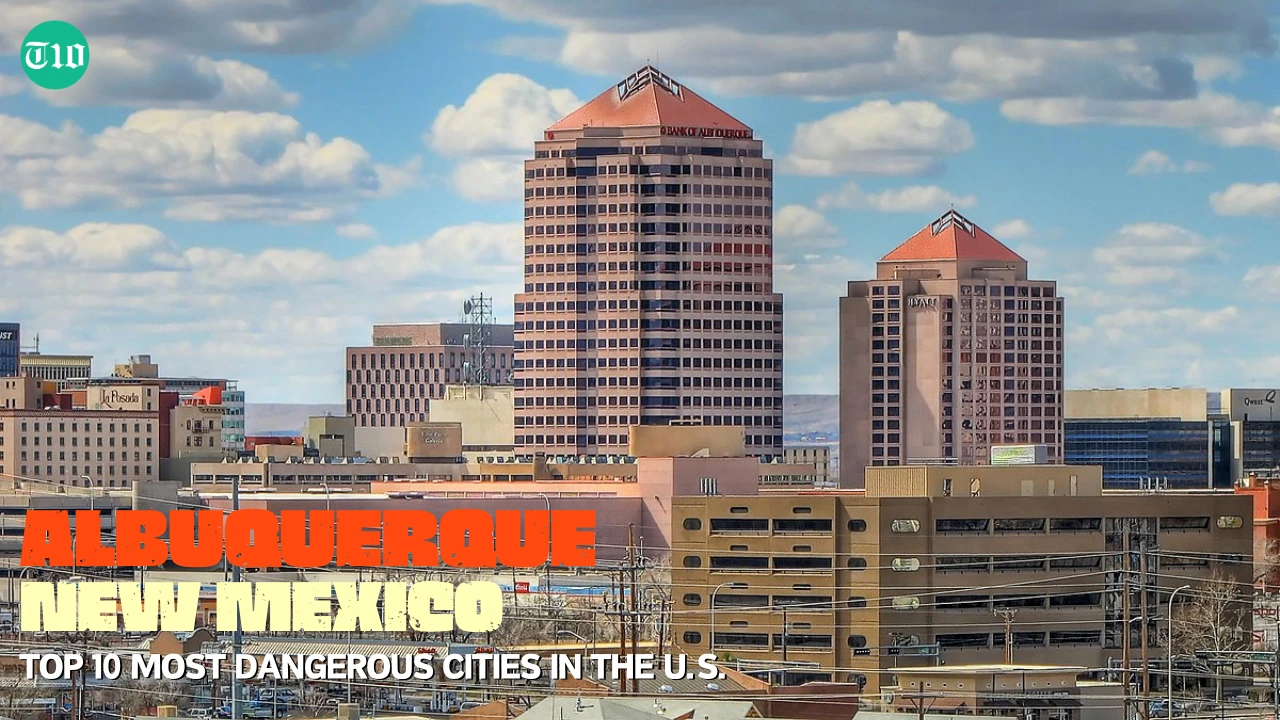
- Violent Crime Rate: Approximately 1,352 per 100,000 residents, with significant property crime issues.
- Key Challenges:
- Property crime, including high rates of vehicle theft and burglaries.
- High levels of substance abuse and homelessness, which impact crime rates.
- Economic challenges and inadequate community resources.
- Notable Areas: Southeast Heights and Barelas are known for higher crime.
- Local Solutions: Focus on substance abuse programs, police partnerships with community organizations, and initiatives addressing homelessness.
Albuquerque, the most populous city in New Mexico, also ranks as one of the top 10 dangerous cities in the U.S. due to its elevated violent and property crime rates.
The city records around 1,352 violent crimes per 100,000 residents, and neighborhoods like Southeast Heights and Barelas are known hotspots.
Property crimes, including vehicle theft and burglary, also contribute to Albuquerque’s reputation for high crime.
The city faces ongoing challenges related to poverty, homelessness, and substance abuse, which have fueled crime rates.
Increased law enforcement efforts have helped to address crime in certain areas, but more work is needed to address the underlying issues that continue to drive high crime rates across the city.
7. Stockton, California
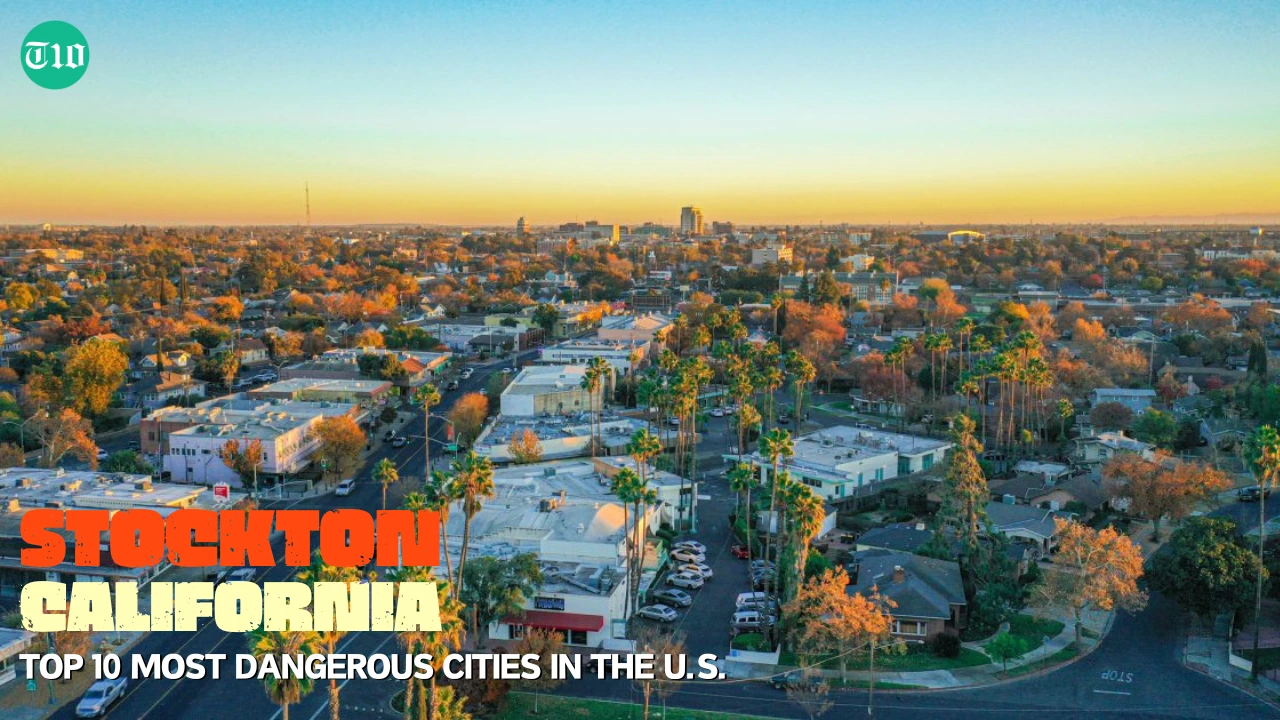
- Violent Crime Rate: Around 1,352 per 100,000 people, with particular issues in Weston Ranch and North Stockton.
- Main Concerns:
- Persistent gang violence and organized crime.
- Robberies, assaults, and drug-related crimes.
- High levels of poverty and limited economic opportunities.
- High-Crime Neighborhoods: Weston Ranch, Downtown, and North Stockton.
- Measures for Improvement: Increased police presence, community-based crime prevention, and job programs.
Stockton, located in California’s Central Valley, has struggled with high crime rates for decades.
Ranking within the top 10 dangerous cities in the U.S. Stockton experiences a violent crime rate of approximately 1,352 incidents per 100,000 people.
Gang activity, robberies, and assaults are common in neighborhoods like Weston Ranch and North Stockton, making these areas particularly risky.
Economic challenges, unemployment, and limited resources contribute to the high crime rate.
However, the persistent socioeconomic issues in the area have proven challenging to resolve, resulting in continued high rates of violent crime and property offenses.
6. Cleveland, Ohio

- Violent Crime Rate: Roughly 1,334 per 100,000 residents, with elevated crime in Central and Union-Miles areas.
- Primary Issues:
- High poverty and economic challenges.
- Drug and property crimes, which often escalate to violence.
- Insufficient access to quality education and employment.
- Notable Neighborhoods: Central, Fairfax, and Union-Miles.
- City Response: Economic revitalization, job creation programs, and community-based policing.
Cleveland, a major city in Ohio, is known for its high poverty rate, which has contributed significantly to its crime levels.
The city sees around 1,334 violent crimes per 100,000 residents, placing it among the top 10 dangerous cities in the U.S. Central Cleveland and neighborhoods like Union-Miles and Fairfax are known for high crime rates, particularly involving property offenses and violent altercations.
Local authorities in Cleveland are working to reduce crime by addressing economic hardship and improving community relations.
Although some improvements have been seen, Cleveland remains a city where residents must be cautious, especially in neighborhoods with higher crime rates.
5. Kansas City, Missouri
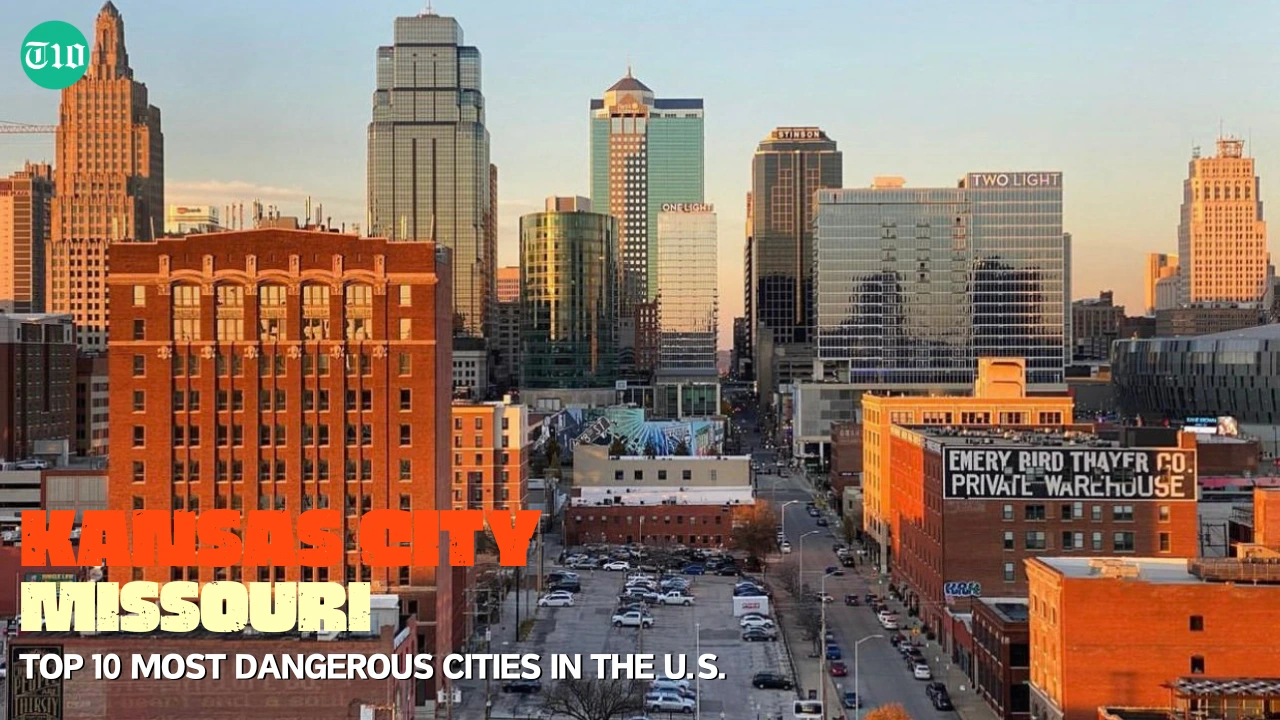
- Violent Crime Rate: Approximately 1,590 per 100,000 residents, impacting neighborhoods on the eastern side of the city.
- Common Crimes: High levels of assault, robbery, and drug-related offenses.
- Factors Driving Crime:
- Gang activity, particularly in East Kansas City.
- Economic disparity and unemployment.
- Areas with limited community services.
- High-Risk Neighborhoods: East Kansas City and areas such as Marlborough Heights.
- Preventative Efforts: Community policing, economic development in impoverished areas, and local partnerships.
Kansas City, Missouri, is a major hub in the Midwest but also has one of the highest violent crime rates, placing it firmly within the top 10 dangerous cities in the U.S.
Approximately 1,590 violent crimes per 100,000 residents, neighborhoods such as East Kansas City and Marlborough Heights are particularly affected.
Crimes such as robbery, assault, and drug offenses are common in these areas, adding to residents’ concerns for safety.
City officials in Kansas City have launched multiple initiatives aimed at reducing crime, including community policing and economic development programs targeted at high-risk areas.
Although these efforts have shown some promise, Kansas City continues to struggle with deep-rooted challenges that contribute to its crime issues, including poverty and gang involvement.
4. Memphis, Tennessee

- Violent Crime Rate: Nearly 1,943 per 100,000 residents, with issues in neighborhoods like Frayser and Whitehaven.
- Key Concerns:
- High poverty rates and limited economic mobility fuel crime.
- Gang presence and violent crime, particularly homicides.
- Youth crime due to lack of engagement and opportunities.
- Areas with High Crime: Frayser, Whitehaven, and Hickory Hill.
- City Measures: Youth engagement programs, police-community partnerships, and economic initiatives to reduce poverty.
Memphis is renowned for its musical heritage, yet it faces significant crime issues that place it among the top 10 dangerous cities in the U.S.
With nearly 1,943 violent crimes per 100,000 residents, neighborhoods like Frayser, Whitehaven, and Hickory Hill report some of the highest incidences of violence.
The city grapples with problems such as gang violence, drug trafficking, and poverty, all of which contribute to its high crime rates.
Efforts to reduce crime in Memphis include youth programs, community outreach, and police initiatives aimed at deterring gang involvement.
However, the socioeconomic challenges faced by many Memphis residents make it difficult to achieve sustained improvement.
3. Baltimore, Maryland
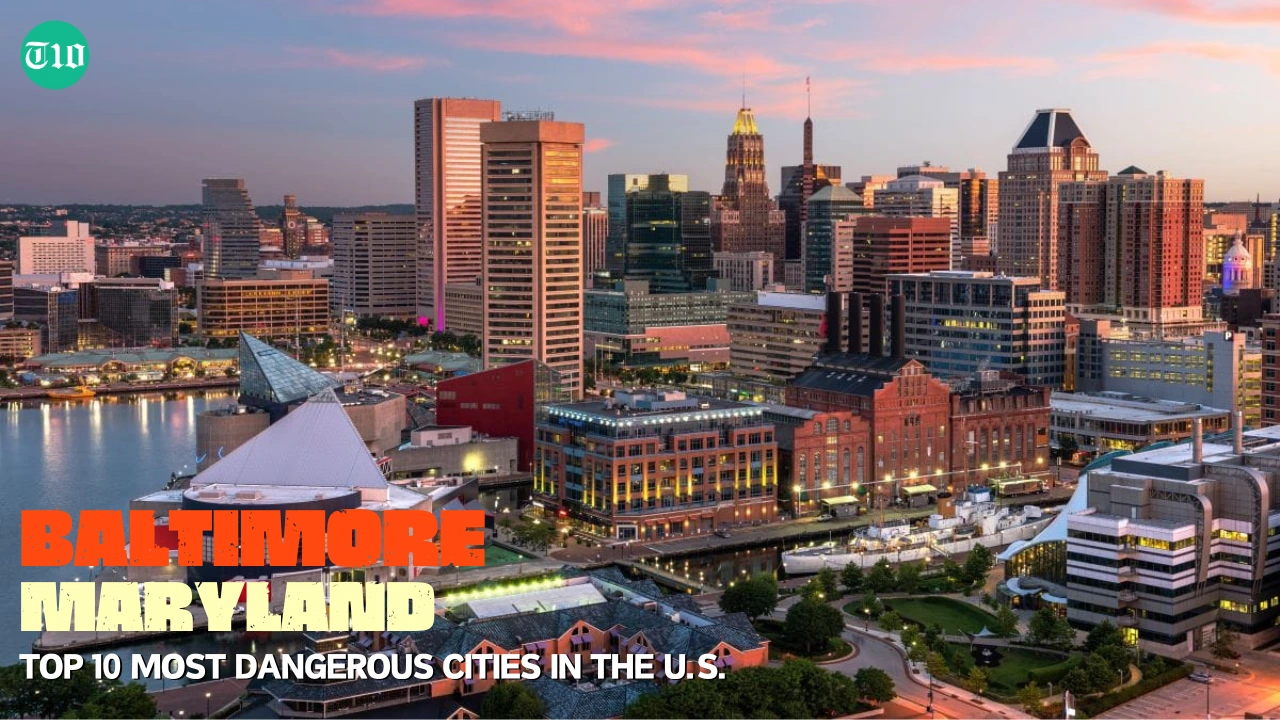
- Violent Crime Rate: Around 1,859 per 100,000 residents, with particularly high homicide and gun violence rates.
- Contributing Factors:
- Drug-related crime is a significant issue due to substance abuse and trafficking.
- High poverty levels in neighborhoods like Sandtown-Winchester.
- Gun violence, especially affecting young people.
- High-Crime Areas: Notable hot spots include Sandtown-Winchester, Upton, and other central neighborhoods.
- Response to Crime: Programs aimed at addiction recovery, community policing, and youth outreach.
Baltimore, a historically rich city in Maryland, struggles with high rates of violent crime, often ranking among the top 10 dangerous cities in the U.S.
Violent crime is particularly pronounced in areas like Sandtown-Winchester and Upton, with approximately 1,859 violent crimes per 100,000 residents.
Issues like drug trafficking and gun violence are widespread, placing considerable strain on law enforcement and community resources.
Baltimore has made efforts to address these issues through initiatives focused on drug rehabilitation, job creation, and community engagement.
Efforts to improve public safety are ongoing, but the city’s high crime rate remains a major concern.
2. Detroit, Michigan
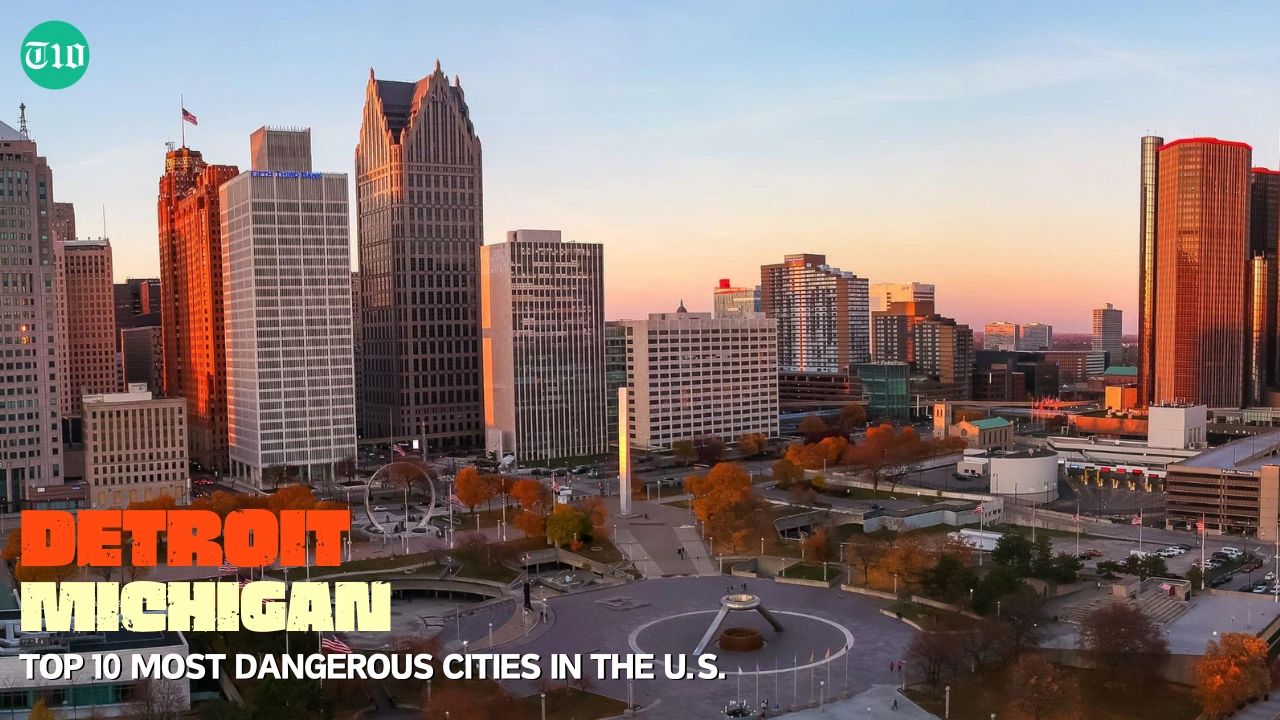
- Violent Crime Rate: Nearly 1,965 per 100,000 residents, placing it consistently high on dangerous city lists.
- Primary Issues:
- Long-standing gang and gun violence, especially in central areas.
- Economic challenges and high poverty rates following the decline of the manufacturing sector.
- Abandoned properties, which create opportunities for criminal activity.
- Notable Areas: Downtown Detroit and nearby neighborhoods experience high crime rates.
- City Initiatives: Increased police efforts, neighborhood watch programs, and community services targeting poverty.
Detroit, Michigan, has long struggled with high crime rates, placing it as one of the top 10 dangerous cities in the U.S.
With a violent crime rate of nearly 1,965 incidents per 100,000 residents, the city faces persistent issues with gang violence, gun crime, and poverty.
Downtown Detroit and surrounding neighborhoods have the highest incidences of violent crime, contributing to the city’s reputation as a challenging place to ensure public safety.
Detroit has implemented various programs to reduce crime, including increased police presence and community-based initiatives aimed at addressing gang violence.
Despite these efforts, Detroit’s history of economic hardship and population decline makes it difficult to fully address the root causes of its high crime rate.
1. St. Louis, Missouri

- Violent Crime Rate: Approximately 2,000 per 100,000 residents, one of the highest in the country.
- Key Crime Types: High rates of homicides, robberies, and aggravated assaults, especially in North St. Louis.
- Factors Contributing to Crime:
- Widespread poverty and economic disparity.
- Gang activity and drug trafficking.
- Limited community resources and insufficient policing.
- Notable Neighborhoods: High crime levels in North St. Louis, specifically impacting areas with limited economic development.
- Efforts to Combat Crime: Community engagement, increased law enforcement, and programs targeting gang violence.
Topping the list of the top 10 dangerous cities in the U.S., St. Louis faces a violent crime rate of about 2,000 incidents per 100,000 residents.
High levels of violent crime, including homicides, assaults, and robberies, are prevalent, particularly in neighborhoods like North St. Louis.
Economic challenges, poverty, and drug-related crime further exacerbate the situation, making St. Louis a city where safety remains a primary concern.
Efforts to reduce crime in St. Louis include a combination of community engagement programs, increased law enforcement, and initiatives targeting economic development.
However, the city’s crime rate remains one of the highest in the country, and residents are advised to take precautions, especially in high-risk neighborhoods.
Conclusion – Top 10 Dangerous Cities in the U.S.
The Top 10 Dangerous Cities in the U.S. face a range of serious safety issues, from violent crime and gang violence to drug trafficking and economic hardship.
While each of these cities faces unique challenges, they are united by underlying socioeconomic issues, such as poverty and limited access to resources, that significantly impact their crime rates.
List of Top 10 Dangerous Cities in the U.S.
The Top 10 Dangerous Cities in the U.S. often face significant safety challenges, with high rates of violent crime, gang activity, and socioeconomic issues.
| Rank | City | Violent Crime Rate (per 100,000) | Key Issues | Notable Areas |
|---|---|---|---|---|
| 1 | St. Louis, MO | 2,000 | Poverty, gang violence, drug crime | North St. Louis |
| 2 | Detroit, MI | 1,965 | Gang activity, gun violence, poverty | Downtown Detroit |
| 3 | Baltimore, MD | 1,859 | Drug abuse, gang activity, gun crime | Sandtown-Winchester, Upton |
| 4 | Memphis, TN | 1,943 | Gang violence, drug trafficking | Frayser, Whitehaven, Hickory Hill |
| 5 | Kansas City, MO | 1,590 | Assaults, robberies, gang presence | East Kansas City, Marlborough Heights |
| 6 | Cleveland, OH | 1,334 | Economic issues, drug crime | Central Cleveland, Union-Miles |
| 7 | Stockton, CA | 1,352 | Gang violence, robberies | Weston Ranch, North Stockton |
| 8 | Albuquerque, NM | 1,352 | Property crime, homelessness | Southeast Heights, Barelas |
| 9 | Milwaukee, WI | 1,332 | Gang violence, economic hardship | Metcalfe Park, Harambee |
| 10 | Indianapolis, IN | 1,334 | Aggravated assault, poverty | Near Eastside, Martindale-Brightwood |
This table summarizes each city’s violent crime rate, primary issues, and notable high-crime areas, helping us understand what drives these cities’ rankings as the Top 10 Dangerous Cities in the U.S.
FAQs Top 10 Dangerous Cities in the U.S.
What is the top deadliest city in the U.S.?
St. Louis, Missouri, is often ranked as one of the deadliest cities in the U.S. due to its high violent crime rates.
What are the Top 10 Most Dangerous Cities in the U.S.?
Some of the most dangerous cities include St. Louis, Detroit, Baltimore, Memphis, Kansas City, Cleveland, Stockton, Albuquerque, Milwaukee, and Indianapolis.
What U.S. city has the highest crime rate in 2024?
St. Louis and Detroit have consistently high crime rates, leading them to top recent rankings in 2024.
Which state has the most violent cities?
Missouri has multiple high-crime cities, including St. Louis and Kansas City.
Where is the most crime concentrated in the U.S.?
Crime is concentrated in urban areas with high poverty rates and limited resources, such as parts of Detroit, Baltimore, and Memphis.
Is Chicago considered a violent city?
Yes, Chicago has a high crime rate, particularly in certain neighborhoods, but it does not top the list.
Is Houston a safe place to live?
Houston has crime concerns, but it generally does not rank among the top 10 most dangerous cities in the U.S.
What are some high-crime neighborhoods in Chicago?
Areas like Englewood and Austin in Chicago are known for higher crime rates.
What is Detroit’s crime rate?
Detroit’s violent crime rate is nearly 1,965 per 100,000 residents, one of the highest in the nation.
Does Albuquerque have a high crime rate?
Yes, Albuquerque has a high rate of violent crime and ranks among the most dangerous cities in the U.S.
What city has the most homeless people?
Los Angeles has one of the highest homeless populations in the U.S., often contributing to social challenges.
What is the safest city in the U.S.?
Cities like Irvine, California, and Frisco, Texas, are often cited as some of the safest cities in the U.S.
Which U.S. city has the most murders?
Baltimore and St. Louis typically have some of the highest murder rates in the country.
What city has the lowest crime rate in the U.S.?
Irvine, California, and other suburban areas tend to have very low crime rates.
What country has the worst crime rate?
Venezuela and South Africa are often cited for high crime rates globally.
What is the deadliest city in the world?
Cities like Tijuana, Mexico, have some of the highest homicide rates in the world.
Is New Orleans safe for tourists?
While popular, New Orleans has areas with high crime, so tourists are advised to remain in safer, well-populated areas.
What are the top 10 states with the highest crime rates in the U.S.?
States like Louisiana, Missouri, and New Mexico frequently rank high for crime rates.
Which U.S. state has the lowest crime rate?
New England states, particularly Maine, have some of the lowest crime rates in the U.S.
What U.S. city has the highest property crime rate?
Seattle, Washington, often ranks high in property crime due to theft and burglary issues.
Quick Recap of Top 10 Dangerous Cities in the U.S.
- St. Louis, Missouri
- Detroit, Michigan
- Baltimore, Maryland
- Memphis, Tennessee
- Kansas City, Missouri
- Cleveland, Ohio
- Stockton, California
- Albuquerque, New Mexico
- Milwaukee, Wisconsin
- Indianapolis, Indiana
Each of the Top 10 Dangerous Cities in the U.S. faces unique challenges that contribute to their high crime rates, from economic difficulties to gang violence and other safety concerns.
By understanding the common and specific issues within these cities, we gain insight into the social and economic conditions impacting urban safety across the nation.










